Land Use and Land Cover Dynamics Analysis of the Togodo Protected Area and Its Surroundings in Southeastern Togo, West Africa
Abstract
1. Introduction
- Identify and map the major LULC categories at the time points 1974, 1986, 2003, and 2016;
- Determine the types and processes of LULC dynamics as well as their rate of occurrence; and
- Analyse land change trajectories.
2. Materials and Methods
2.1. Study Area
2.2. Satellite Imagery
2.3. Land Use and Land Cover Classification
2.3.1. Classification of Landsat Images
2.3.2. Classification of the Sentinel 2 Image
2.4. Accuracy Assessment
2.5. Land Use and Land Cover Change Assessment
2.5.1. Intensity Analysis
2.5.2. Trajectory Analysis
2.6. Climatic Trends
Statistical Analysis
- Z: z-score transformation test;
- µ1 and µ2: rainfall averages of the two periods;
- σ21 and σ22: variances of the two samples;
- n1 and n2: number of years observed.
3. Results
3.1. Land Use and Land Cover Maps and Contingency Table
3.2. Time Interval Level Intensity Analysis
3.3. Category Level Intensity Analysis
3.4. Transition Level Intensity Analysis
3.5. Trajectory Analysis
3.6. Long-Term Annual Rainfall Data Analyses
4. Discussion
4.1. LULC Mapping and Accuracy
4.2. Influence of Climate, Human Actions, and Invasive Plants
4.3. Increasing Anthropogenic Pressures
4.4. The Usefulness of Associating Intensity and Trajectory Analysis
5. Conclusions
Author Contributions
Funding
Acknowledgments
Conflicts of Interest
Appendix A. Areal Distribution of the LULC Categories in and around the Togodo Protected Area in 1974, 1986, 2003, and 2016.
| 1974 | 1986 | 2003 | 2016 | |||||
|---|---|---|---|---|---|---|---|---|
| LCC | Areas (ha) | % | Areas (ha) | % | Areas (ha) | % | Areas (ha) | % |
| Forests | 8388.75 | 7.03 | 9988.31 | 8.37 | 6240.35 | 5.23 | 6994.36 | 5.86 |
| Savannahs | 71,554.06 | 59.97 | 66,779.63 | 55.97 | 44,151.83 | 37.00 | 19,696.13 | 16.51 |
| Croplands | 39,371.74 | 33.00 | 41,915.87 | 35.13 | 68,050.69 | 57.03 | 91,498.8 | 76.68 |
| Built areas | 8.49 | 0.01 | 357.73 | 0.30 | 521.32 | 0.44 | 790.06 | 0.66 |
| Water | 0.00 | 0.00 | 281.50 | 0.24 | 358.85 | 0.30 | 343.69 | 0.29 |
Appendix B. Land Change Trajectories Definition and Proportion.
| Trajectory Classes | Definition | Trajectories | Percentage of Area (%) |
|---|---|---|---|
| Permanent cropland | At least 42-years permanent cropland | CCCC (CCCC) | 25.28 |
| Permanent vegetation | At least 42-years permanent forest or savannah | FFFF, FFFS, FFSF, FFSS, FSFF, FSFS, FSSF, FSSS, SFFF, SFFS, SFSF, SFSS, SSFF, SSFS, SSSF, SSSS (VVVV) | 19.55 |
| Recent cropland | Conversion from forest or savannah to cropland between 2003 and 2016 | FFFC, FFSC, FSFC, FSSC, SFFC, SFSC, SSFC, SSSC, (VVVC) | 20.87 |
| Recent reforestation | Abandoned cropland between 2003 and 2016 | CCCF, CCCS (CCCV) | 0.01 |
| Cropland-fallow cycle | Old and recent Cropland-fallow cycles | FFCF, FFCS, FSCF, FSCS, SSCF, SSCS, SFCF, SFCS, FCCF, FCCS, SCCF, SCCS, CFCF, CFCS, CSCF, CSCS, FCFC, FCSC, SCFC, SCSC, CFFC, CFSC, CSFC, CSSC, CCFC, CCSC FCFF, FCFS, FCSF, FCSS, SCFF, SCFS, SCSF, SCSS (VVCV, VCCV, CVCV VCVC, CVVC, CCVC, VCVV) | 0.98 |
| Young cropland | At least 13-years permanent cropland from forest or savannah | FFCC, FSCC, SFCC, SSCC, CFCC, CSCC (VVCC) | 22.54 |
| Young reforestation | At least 13-years permanent forest or savannah from cropland | CCFF, CCFS, CCSF, CCSS (CCVV) | 0.3 |
| Old cropland | At least 30-years permanent cropland from forest or savannah | FCCC, SCCC (VCCC) | 7.23 |
| Old reforestation | At least 30-years permanent forest or savannah from cropland | CFFF, CFFS, CFSF, CFSS, CSFF, CSFS, CSSF, CSSS (CVVV) | 1.52 |
| Other | Any conversion involving settlements and water | OOOO (OOOO) | 1.72 |
Appendix C. Accuracy Assessment Summary Table (A3: 1974; A4: 1986; A5: 2003, and A6: 2016)
| 1974 | Unbiased Accuracy Assessment Summary | ||||
|---|---|---|---|---|---|
| Class | Estimated Area (hectares) | ± 95% CI | User’s Accuracy (%) | Producer’s Accuracy (%) | Overall Accuracy (%) |
| Forest | 10,732.15 | 1930.04 | 82.98 | 64.86 | 76.79 |
| Savannah | 63,264.99 | 4209.65 | 76.35 | 86.36 | |
| Cropland | 45,095.79 | 4125.06 | 76.27 | 66.59 | |
| Built area | 230.05 | 435.98 | 90.00 | 3.31 | |
| 1986 | Unbiased Accuracy Assessment Summary | ||||
|---|---|---|---|---|---|
| Class | Estimated Area (hectares) | ± 95% CI | User’s Accuracy (%) | Producer’s Accuracy (%) | Overall Accuracy (%) |
| Forest | 11,993.92 | 3206.37 | 85.37 | 71.09 | 82.46 |
| Savannah | 59,441.17 | 6240.03 | 81.52 | 91.59 | |
| Cropland | 45,268.91 | 6206.11 | 83.08 | 76.92 | |
| Built area | 966.82 | 1264.85 | 90.00 | 33.30 | |
| Water | 1652.23 | 1903.04 | 100.00 | 17.04 | |
| 2003 | Unbiased Accuracy Assessment Summary | ||||
|---|---|---|---|---|---|
| Class | Estimated Area (hectares) | ± 95% CI | User’s Accuracy (%) | Producer’s Accuracy (%) | Overall Accuracy (%) |
| Forest | 7978.36 | 2079.01 | 94.44 | 73.87 | 90.5 |
| Savannah | 43,660.68 | 4237.93 | 88.10 | 89.09 | |
| Cropland | 66,374.16 | 4133.94 | 91.79 | 94.11 | |
| Built area | 984.22 | 996.09 | 91.38 | 48.40 | |
| Water | 325.62 | 59.33 | 88.24 | 97.24 | |
| 2016 | Unbiased Accuracy Assessment Summary | ||||
|---|---|---|---|---|---|
| Class | Estimated Area (hectares) | ± 95% CI | User’s Accuracy (%) | Producer’s Accuracy (%) | Overall Accuracy (%) |
| Forest | 7608.59 | 1053.31 | 88.78 | 81.61 | 88.08 |
| Savannah | 19,283.23 | 1849.80 | 83.48 | 85.27 | |
| Cropland | 26,252.27 | 1653.63 | 90.95 | 89.66 | |
| Fallow | 37,250.36 | 2218.50 | 88.70 | 87.73 | |
| Plantation | 27,580.33 | 1883.61 | 87.42 | 91.21 | |
| Built area | 989.38 | 361.85 | 92.31 | 73.71 | |
| Water | 358.88 | 20.95 | 100.00 | 95.77 | |
References
- Assessment, M.E. Ecosystems and Human Well-Being: Synthesis; Island Press: Washington, DC, USA, 2005; ISBN 978-1-59726-040-4. [Google Scholar]
- Ojima, D.S.; Galvin, K.A.; Turner, B.L. The global impact of land-use change. Bioscience 1994, 44, 300–304. [Google Scholar] [CrossRef]
- Foley, J.A.; DeFries, R.; Asner, G.P.; Barford, C.; Bonan, G.; Carpenter, S.R.; Chapin, F.S.; Coe, M.T.; Daily, G.C.; Gibbs, H.K.; et al. Global consequences of land use. Science 2005, 309, 570–574. [Google Scholar] [CrossRef] [PubMed]
- Lambin, E.F.; Geist, H.J. Land-Use and Land-Cover Change: Local Processes and Global Impacts; Springer Science & Business Media: Berlin/Heidelberg, Germany, 2008; ISBN 3-540-32202-7. [Google Scholar]
- Wang, W.; Zhang, C.; Allen, J.M.; Li, W.; Boyer, M.A.; Segerson, K.; Silander, J.A. Analysis and prediction of land use changes related to invasive species and major driving forces in the state of connecticut. Land 2016, 5, 25. [Google Scholar] [CrossRef]
- Lambin, E.F.; Geist, H.J.; Lepers, E. Dynamics of land-use and land-cover change in tropical regions. Annu. Rev. Environ. Resour. 2003, 28, 205–241. [Google Scholar] [CrossRef]
- Li, W.; MacBean, N.; Ciais, P.; Defourny, P.; Lamarche, C.; Bontemps, S.; Houghton, R.A.; Peng, S. Gross and net land cover changes in the main plant functional types derived from the annual ESA CCI land cover maps (1992–2015). Earth Syst. Sci. Data 2018, 10, 219–234. [Google Scholar] [CrossRef]
- Turner, B.L.; Meyer, W.B.; Skole, D.L. Global land-use/land-cover change: Towards an integrated study. Ambio Stockh. 1994, 23, 91–95. [Google Scholar]
- Deng, X.; Li, Z. A review on historical trajectories and spatially explicit scenarios of land-use and land-cover changes in China. J. Land Use Sci. 2016, 11, 709–724. [Google Scholar] [CrossRef]
- Ouedraogo, I.; Savadogo, P.; Tigabu, M.; Cole, R.; Odén, P.C.; Ouadba, J.-M. Trajectory Analysis of Forest Cover Change in the Tropical Dry Forest of Burkina Faso, West Africa. Landsc. Res. 2011, 36, 303–320. [Google Scholar] [CrossRef]
- Uuemaa, E.; Antrop, M.; Roosaare, J.; Marja, R.; Mander, Ü. Landscape Metrics and Indices: An Overview of Their Use in Landscape Research. Living Rev. Landsc. Res. 2009, 3, 1–28. [Google Scholar] [CrossRef]
- Huang, B.; Huang, J.; Pontius, R.G.; Tu, Z. Comparison of Intensity Analysis and the land use dynamic degrees to measure land changes outside versus inside the coastal zone of Longhai, China. Ecol. Indic. 2018, 89, 336–347. [Google Scholar] [CrossRef]
- Badjana, H.M.; Helmschrot, J.; Selsam, P.; Wala, K.; Flügel, W.-A.; Afouda, A.; Akpagana, K. Land cover changes assessment using object-based image analysis in the Binah River watershed (Togo and Benin). Earth Space Sci. 2015, 2, 403–416. [Google Scholar] [CrossRef]
- Mitsuda, Y.; Ito, S. A review of spatial-explicit factors determining spatial distribution of land use/land-use change. Landsc. Ecol. Eng. 2011, 7, 117–125. [Google Scholar] [CrossRef]
- Hernández-Moreno, Á.; Miranda, M.D.; Arellano, E.; Dobbs, C. Landscape trajectories and their effect on fragmentation for a Mediterranean semi-arid ecosystem in Central Chile. J. Arid. Environ. 2016, 127, 74–81. [Google Scholar] [CrossRef]
- Disperati, L.; Virdis, S.G. Assessment of land-use and land-cover changes from 1965 to 2014 in Tam Giang-Cau Hai Lagoon, central Vietnam. Appl. Geogr. 2015, 58, 48–64. [Google Scholar] [CrossRef]
- Diwediga, B.; Agodzo, S.; Wala, K.; Le, Q.B. Assessment of multifunctional landscapes dynamics in the mountainous basin of the Mo River (Togo, West Africa). J. Geogr. Sci. 2017, 27, 579–605. [Google Scholar] [CrossRef]
- Akpagana, K.; Guelly, K.A.; Gumedzoe, Y.M. Une adventice en voie d’envahissement du Territoire togolais: Eupatorium odoratum L. [syn. Chromolaena odorata (L.) R.M. King & Robinson] (Compositae). Acta Bot. Gallica 1993, 140, 535–543. [Google Scholar] [CrossRef]
- Vilà, M.; Ibáñez, I. Plant invasions in the landscape. Landsc. Ecol. 2011, 26, 461–472. [Google Scholar] [CrossRef]
- Ramankutty, N.; Graumlich, L.; Achard, F.; Alves, D.; Chhabra, A.; DeFries, R.; Foley, J.A.; Geist, H.; Houghton, R.A.; Goldewijk, K.K.; et al. Global land-cover change: Recent progress, remaining challenges. In Land-Use and Land-Cover Change; Springer: Berlin/Heidelberg, Germany, 2006; pp. 9–39. [Google Scholar]
- Kokou, K.; Caballé, G. Les îlots forestiers de la plaine côtière togolaise. Bois Forets Trop. 2000, 263, 39–51. [Google Scholar] [CrossRef]
- Atsri, H.; Konko, Y.; Cuni-Sanchez, A.; Abotsi, K.E.; Kokou, K. Changes in the West African forest-savanna mosaic, insights from central Togo. PLoS ONE 2018, 13, e0203999. [Google Scholar] [CrossRef]
- Laurin, G.V.; Puletti, N.; Hawthorne, W.; Liesenberg, V.; Corona, P.; Papale, D.; Chen, Q.; Valentini, R. Discrimination of tropical forest types, dominant species, and mapping of functional guilds by hyperspectral and simulated multispectral Sentinel-2 data. Remote Sens. Environ. 2016, 176, 163–176. [Google Scholar] [CrossRef]
- Oszwald, J.; Antoine, L.; De Sartre, X.A.; Marcello, T.; Gond, V. Analyse des directions de changement des états de surface végétaux pour renseigner la dynamique du front pionnier de Maçaranduba (Brésil) entre 1997 et 2006. Télédétection 2010, 9, 97–111. [Google Scholar]
- Saadi, S.; Gintzburger, G. A spatial desertification indicator for Mediterranean arid rangelands: A case study in Algeria. Rangel. J. 2013, 35, 47. [Google Scholar] [CrossRef]
- Müller-Wilm, U.; Devignot, O.; Pessiot, L. Sen2Cor Software Release Note. Ref. S2-PDGS-MPC-L2A-SRN-V2.3; ESA: Paris, France, 2016; Volume 1. [Google Scholar]
- Huang, C.; Davis, L.S.; Townshend, J.R.G. An assessment of support vector machines for land cover classification. Int. J. Remote Sens. 2002, 23, 725–749. [Google Scholar] [CrossRef]
- Mountrakis, G.; Im, J.; Ogole, C. Support vector machines in remote sensing: A review. ISPRS J. Photogramm. Remote Sens. 2011, 66, 247–259. [Google Scholar] [CrossRef]
- Pal, M.; Mather, P.M. Support vector machines for classification in remote sensing. Int. J. Remote Sens. 2005, 26, 1007–1011. [Google Scholar] [CrossRef]
- The Food and Agriculture Organization (FAO). Carte écologique du couvert végétal du Togo; The Food and Agriculture Organization: Rome, Italie, 1978. [Google Scholar]
- Afidégnon, D.; Carayon, J.-L.; Fromard, F. Carte de la Végétation du Togo; Laboratoire de Botanique et Ecologie Végétale & Laboratoire d’Ecologie Tropicale: Lomé, Togo, 2002. [Google Scholar]
- Blaschke, T.; Hay, G.J. Object-oriented image analysis and scale-space: Theory and methods for modeling and evaluating multiscale landscape structure. Int. Arch. Photogram. Remote Sens. 2001, 34, 22–29. [Google Scholar]
- Benz, U.C.; Hofmann, P.; Willhauck, G.; Lingenfelder, I.; Heynen, M. Multi-resolution, object-oriented fuzzy analysis of remote sensing data for GIS-ready information. ISPRS J. Photogramm. Remote Sens. 2004, 58, 239–258. [Google Scholar] [CrossRef]
- Baatz, M.; Schäpe, A. Multiresolution segmentation: An optimization approach for high quality multi-scale image segmentation. In Angewandte Geographische Informations-Verarbeitung XII; Strobl, J., Blaschke, T., Griesebner, G., Eds.; Wichmann-Verlag: Karlsruhe, Germany, 2000; pp. 12–23. [Google Scholar]
- Robin, M. La Télédétection; Nathan: Paris, France, 1998. [Google Scholar]
- Sparfel, L.; Gourmelon, F.; Le Berre, I. Approche orientée-objet de l’occupation des sols en zone côtière. Rev. Télédétection 2008, 8, 237–256. [Google Scholar]
- Olofsson, P.; Foody, G.M.; Stehman, S.V.; Woodcock, C.E. Making better use of accuracy data in land change studies: Estimating accuracy and area and quantifying uncertainty using stratified estimation. Remote Sens. Environ. 2013, 129, 122–131. [Google Scholar] [CrossRef]
- Pontius, R.G.; Millones, M. Death to Kappa: Birth of quantity disagreement and allocation disagreement for accuracy assessment. Int. J. Remote Sens. 2011, 32, 4407–4429. [Google Scholar] [CrossRef]
- Braimoh, A.K.; Vlek, P.L.G. Land-cover change trajectories in northern Ghana. Environ. Manag. 2005, 36, 356–373. [Google Scholar] [CrossRef] [PubMed]
- Pontius, J.R.G.; Gao, Y.; Giner, N.M.; Kohyama, T.S.; Osaki, M.; Hirose, K. Design and interpretation of intensity analysis illustrated by land change in central Kalimantan, Indonesia. Land 2013, 2, 351–369. [Google Scholar] [CrossRef]
- Akodéwou, A.; Oszwald, J.; Akpavi, S.; Gazull, L.; Akpagana, K.; Gond, V. Problématique des plantes envahissantes au sud du Togo (Afrique de l’Ouest): Apport de l’analyse systémique paysagère et de la télédétection. Biotechnol. Agron. Société Environ. 2019, 23, 88–103. [Google Scholar] [CrossRef]
- Zomlot, Z.; Verbeiren, B.; Huysmans, M.; Batelaan, O. Trajectory analysis of land use and land cover maps to improve spatial–temporal patterns, and impact assessment on groundwater recharge. J. Hydrol. 2017, 554, 558–569. [Google Scholar] [CrossRef]
- Harris, I.; Jones, P.; Osborn, T.J.; Lister, D.H. Updated high-resolution grids of monthly climatic observations—The CRU TS3.10 dataset. Int. J. Clim. 2013, 34, 623–642. [Google Scholar] [CrossRef]
- Hirche, A.; Boughani, A.; Salamani, M. Évolution de la pluviosité annuelle dans quelques stations arides algériennes. Sci. Chang. Planétaires Sécheresse 2007, 18, 314–320. [Google Scholar] [CrossRef]
- McKee, T.B.; Doesken, N.J.; Kleist, J. The relationship of drought frequency and duration to time scales. In Proceedings of the 8th Conference on Applied Climatology, American Meteorological Society, Boston, MA, USA, 17–22 January 1993; Volume 17, pp. 179–183. [Google Scholar]
- Gremy, F.; Salmon, D. Bases Statistiques. Sciences Mathématiques au Service de la Médecine; Dunod: Paris, France, 1969. [Google Scholar]
- Piquer-Rodríguez, M.; Butsic, V.; Gärtner, P.; Macchi, L.; Baumann, M.; Pizarro, G.G.; Volante, J.N.; Gasparri, I.; Kuemmerle, T. Drivers of agricultural land-use change in the Argentine Pampas and Chaco regions. Appl. Geogr. 2018, 91, 111–122. [Google Scholar] [CrossRef]
- Huang, J.; Pontius, R.G.; Li, Q.; Zhang, Y. Use of intensity analysis to link patterns with processes of land change from 1986 to 2007 in a coastal watershed of southeast China. Appl. Geogr. 2012, 34, 371–384. [Google Scholar] [CrossRef]
- Aguirre-Gutiérrez, J.; Seijmonsbergen, A.C.; Duivenvoorden, J.F. Optimizing land cover classification accuracy for change detection, a combined pixel-based and object-based approach in a mountainous area in Mexico. Appl. Geogr. 2012, 34, 29–37. [Google Scholar] [CrossRef]
- Chatelain, C.; Gautier, L.; Spichiger, R. A recent history of forest fragmentation in southwestern Ivory Coast. Biodivers. Conserv. 1996, 5, 37–53. [Google Scholar] [CrossRef]
- Kpedenou, K.D.; Boukpessi, T.; Tchamie, T.T.K. Quantification des changements de l’occupation du sol dans la préfecture de Yoto (sud-est Togo) à l’aide de l’imagerie satellitaire Landsat. Rev. Sci. Environ. 2016, 13, 137–156. [Google Scholar]
- Braimoh, A.K.; Vlek, P.L.G. Land-cover change analyses in the Volta Basin of Ghana. Earth Interact. 2004, 8, 1–17. [Google Scholar] [CrossRef]
- Scheiter, S.; Higgins, S.I. Impacts of climate change on the vegetation of Africa: An adaptive dynamic vegetation modelling approach. Glob. Chang. Biol. 2009, 15, 2224–2246. [Google Scholar] [CrossRef]
- Malahlela, O.E.; Cho, M.A.; Mutanga, O. Mapping the occurrence of Chromolaena odorata (L.) in subtropical forest gaps using environmental and remote sensing data. Biol. Invasions 2015, 17, 2027–2042. [Google Scholar] [CrossRef]
- Dimobe, K.; Wala, K.; Batawila, K.; Dourma, M.; Agbelessessi, W.Y.; Akpagana, K. Analyse spatiale des différentes formes de pressions anthropiques dans la réserve de faune de l’Oti-Mandouri (Togo). VertigO Rev. Électronique En Sci. Environ. 2012. [Google Scholar] [CrossRef]
- Direction Générale de la Sûreté Nationale. Recensement Général de la Population et de l’Habitat au Togo. Résultats Définitifs; Direction Générale de la Sûreté Nationale: Lomé, Togo, 2010; p. 65. [Google Scholar]
- Mainguet, M. Sécheresse, désertification et albédo des sols (drought, desertisation and soils albedo). Bull. Assoc. Géographes Fr. 1996, 73, 324–335. [Google Scholar] [CrossRef]
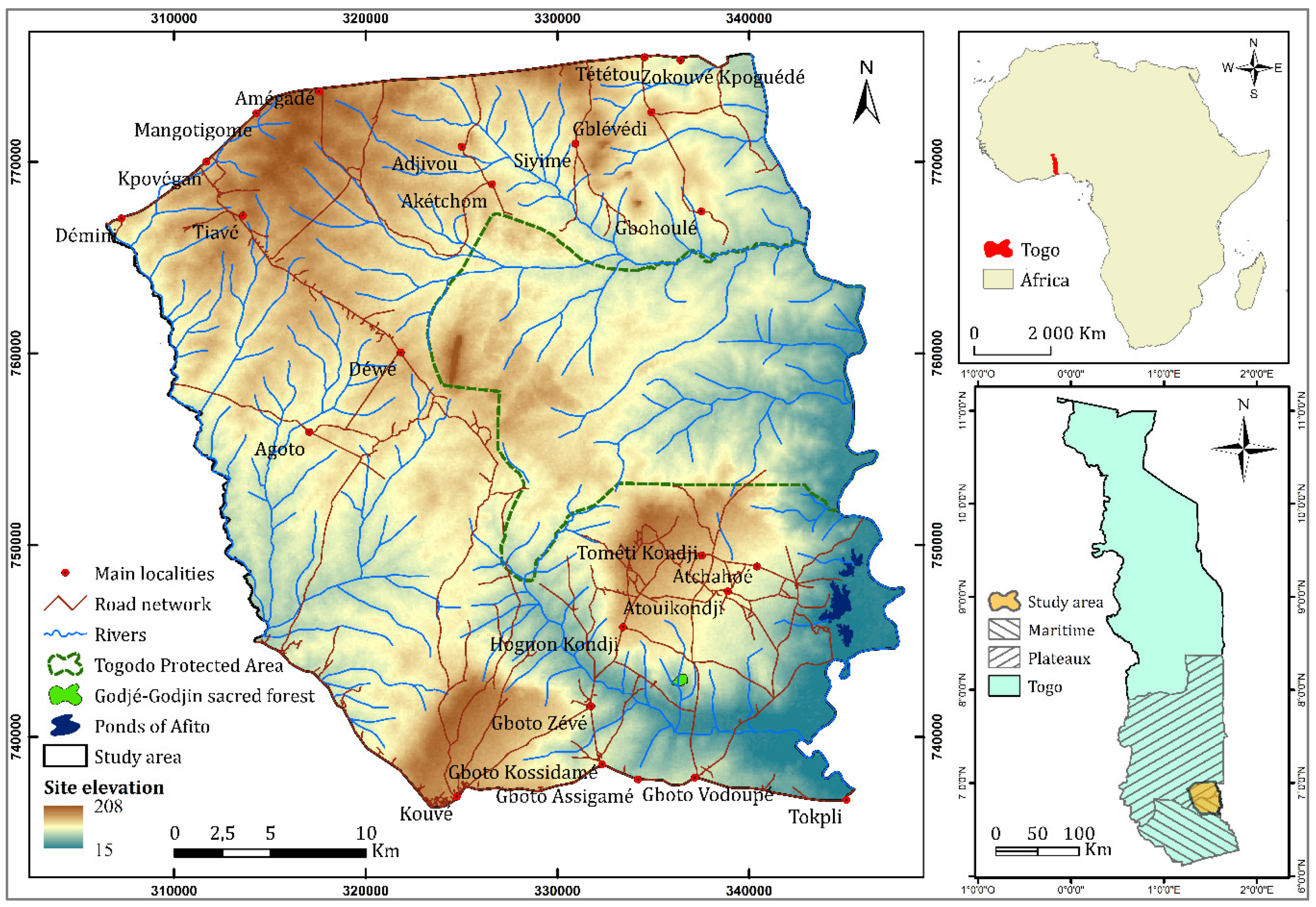
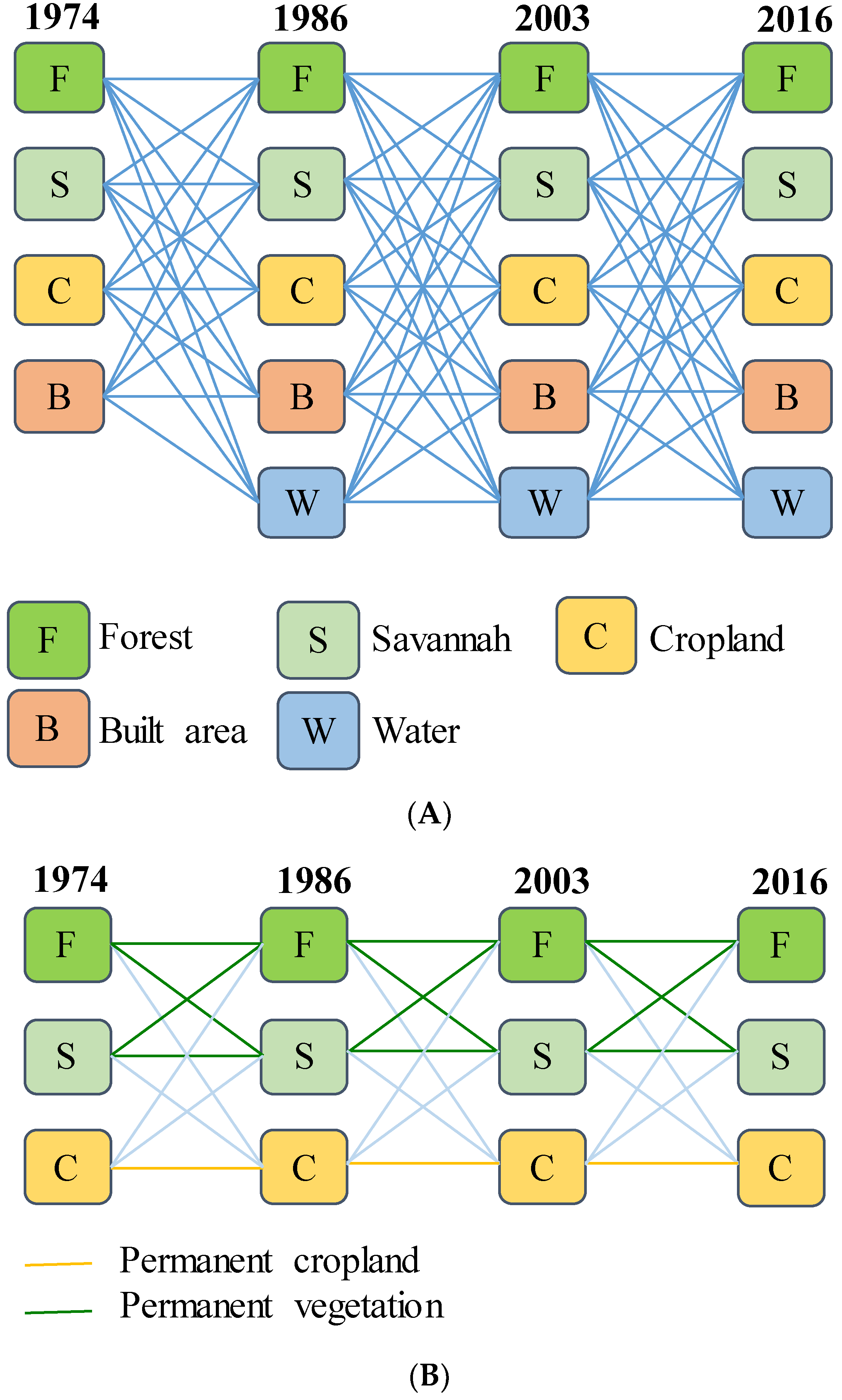

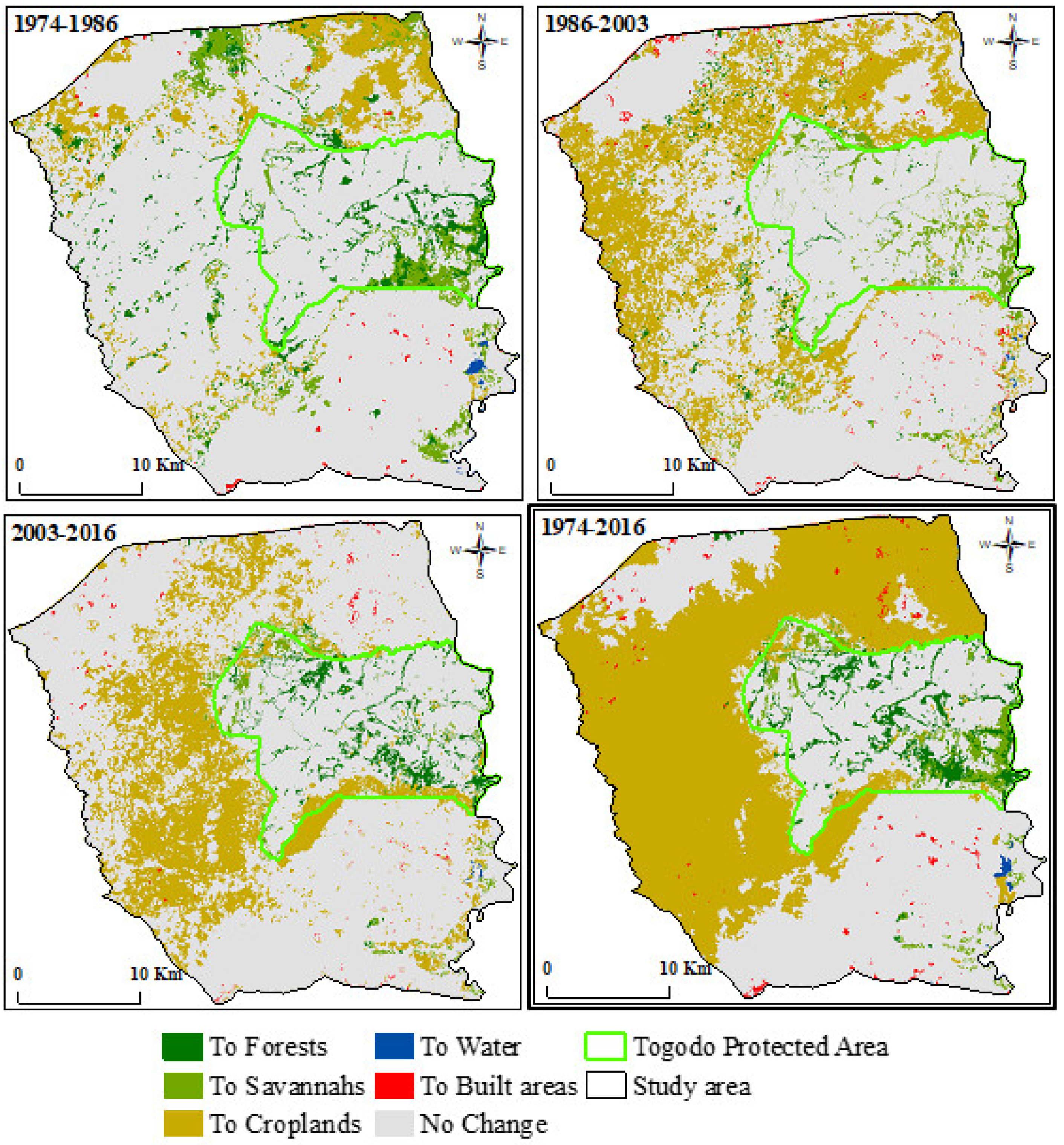
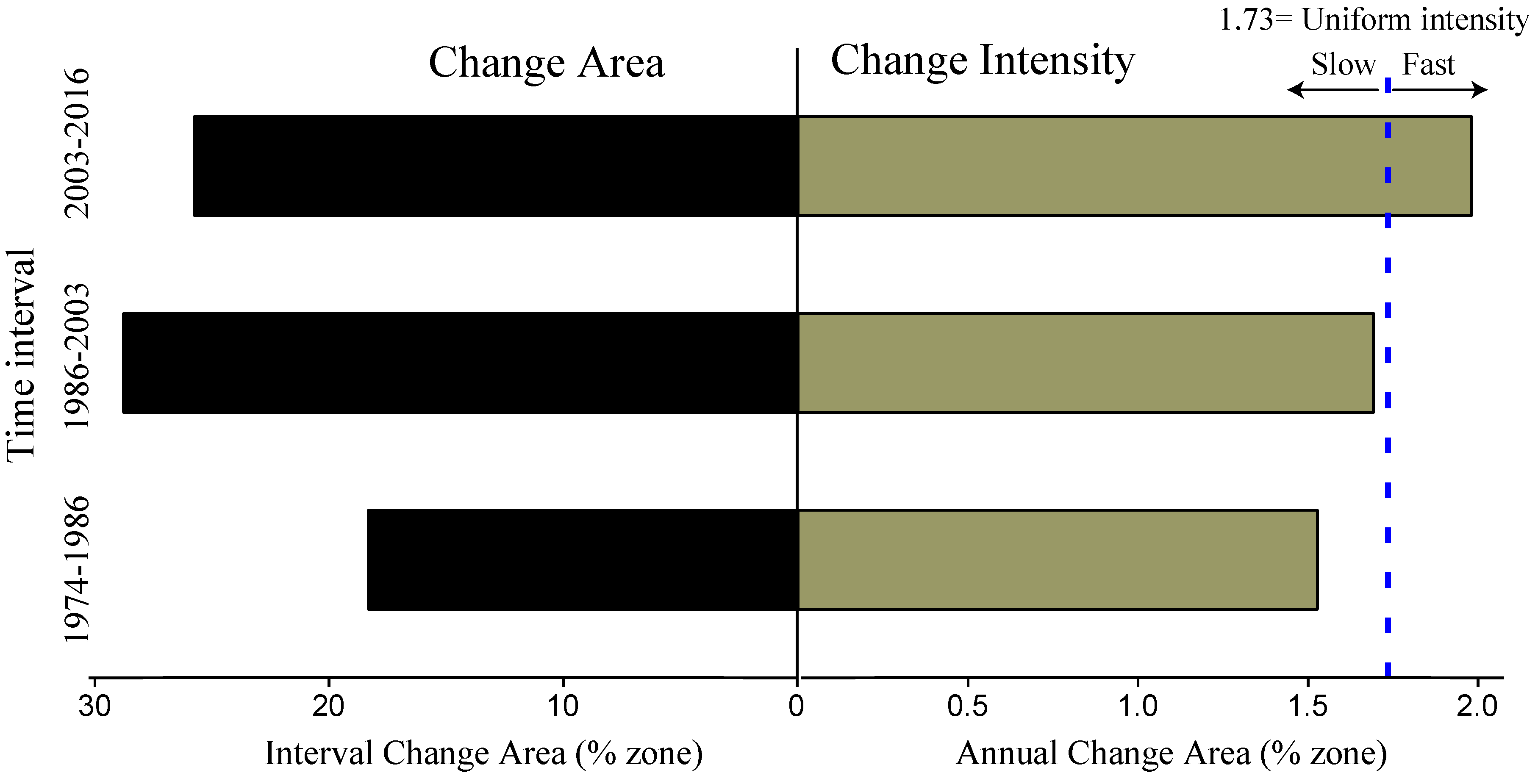

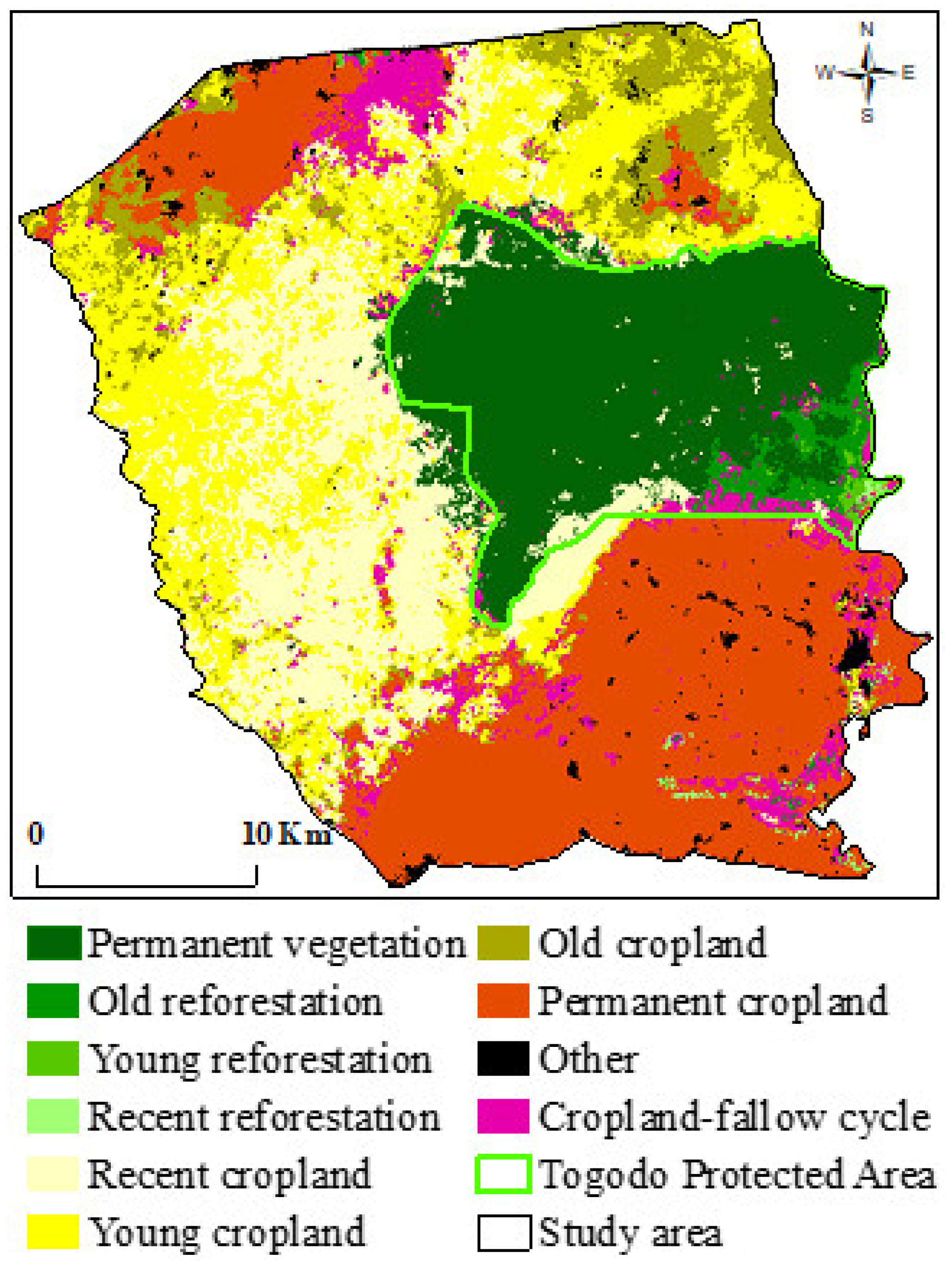

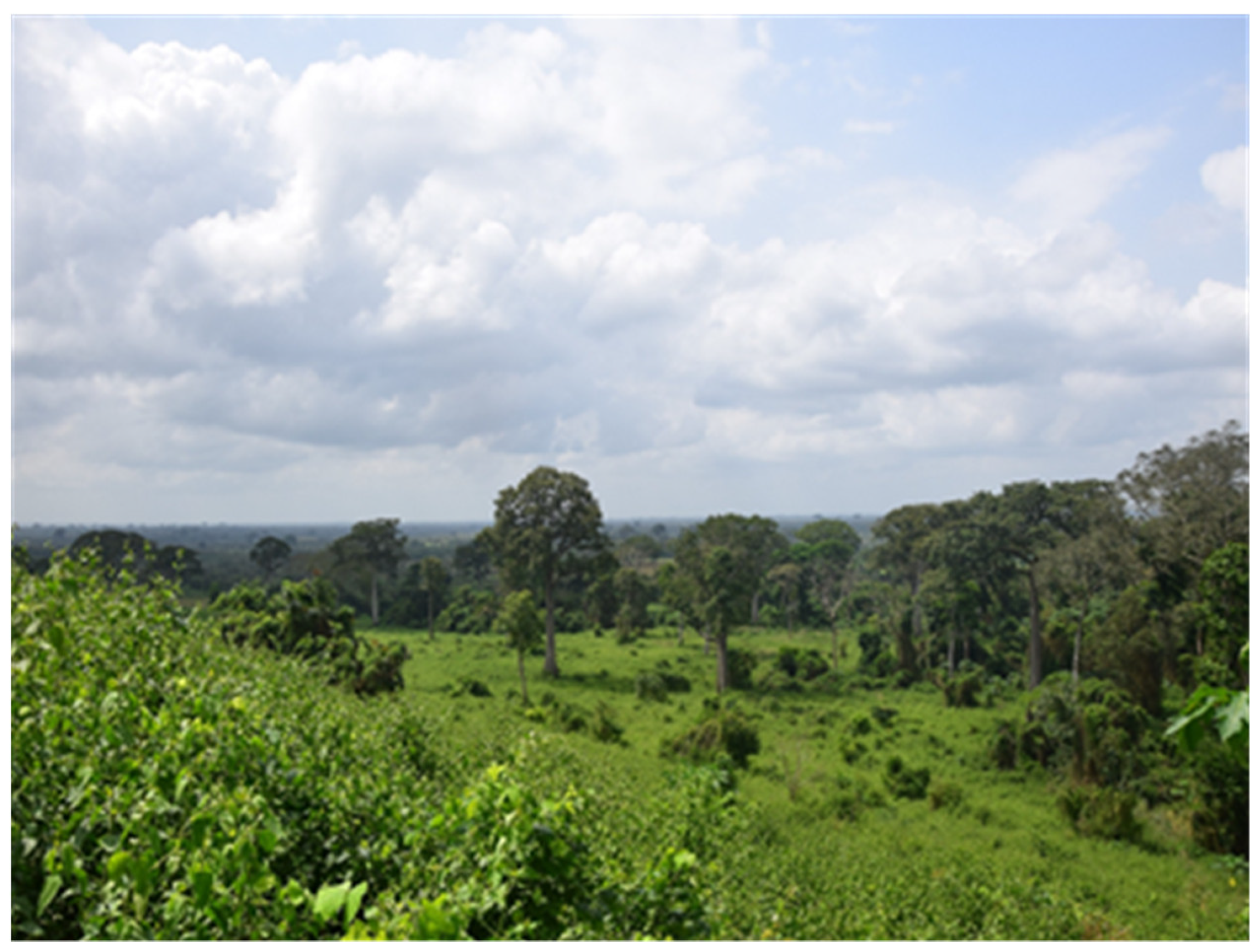
| Land Use and Land Cover Type | Definition | |
|---|---|---|
| 1 | Forest | Close canopy woody vegetation and riparian forests (>75 trees per ha, a minimum height of 5 m at maturity) |
| 2 | Savannah | Treeless open canopy vegetation (<75 trees per ha) with a mixture of shrub and scattered grasslands |
| 3 | Cropland | Agricultural land with crops (cereal, vegetable, and fruits) and fallows less than 3 years |
| 4 | Built area | Areas occupied by settlements (cities, villages, roads, and other building) |
| 5 | Water | Rivers, ponds, and reservoirs |
| From Category | Time Interval | Forest | Savannah | Cropland | Sum | Loss | ||||||
|---|---|---|---|---|---|---|---|---|---|---|---|---|
| Forest | 1974–1986 | 3.8 | 1.2 | 1.4 | Ta | 2.0 | 2.4 | Ta | 7.0 | 3.3 | ||
| 1986–2003 | 4.0 | 2.3 | 1.6 | Ta | 2.0 | 1.4 | Av | 8.4 | 4.4 | |||
| 2003–2016 | 3.1 | 0.7 | 1.1 | Ta | 1.3 | 2.0 | Av | 5.2 | 2.1 | |||
| Savannah | 1974–1986 | 3.3 | 0.5 | Ta | 50.7 | 5.9 | 0.8 | Av | 60.0 | 9.2 | ||
| 1986–2003 | 0.9 | 0.1 | Ta | 33.4 | 21.4 | 2.3 | Ta | 56.0 | 22.5 | |||
| 2003–2016 | 2.4 | 0.5 | Ta | 15.0 | 19.5 | 4.1 | Ta | 37.0 | 22.0 | |||
| Cropland | 1974–1986 | 1.3 | 0.3 | Av | 4.0 | 1.0 | Av | 27.2 | 33.0 | 5.8 | ||
| 1986–2003 | 0.3 | 0.1 | Av | 1.2 | 0.2 | Av | 33.5 | 35.1 | 1.7 | |||
| 2003–2016 | 0.3 | 0.0 | Av | 0.7 | 0.1 | Av | 55.6 | 57.0 | 1.4 | |||
| Sum | 1974–1986 | 8.4 | 56.0 | 35.1 | 100.0 | 18.3 | ||||||
| 1986–2003 | 5.2 | 37.0 | 57.0 | 100.0 | 28.8 | |||||||
| 2003–2016 | 5.9 | 16.5 | 76.7 | 100.0 | 25.8 | |||||||
| Gain | 1974–1986 | 4.6 | 5.2 | 8.0 | 18.3 | |||||||
| 1986–2003 | 1.2 | 3.6 | 23.6 | 28.8 | ||||||||
| 2003–2016 | 2.7 | 1.5 | 21.1 | 25.8 | ||||||||
| Wtj | 1974–1986 | 0.4 | 1.1 | 1.0 | ||||||||
| 1986–2003 | 0.1 | 0.5 | 2.1 | |||||||||
| 2003–2016 | 0.2 | 0.2 | 3.8 | |||||||||
| Nb of Years Per Sequence | Frequency | Nb of Years Observed | Average Number of Years Per Sequence | |
|---|---|---|---|---|
| dry sequences | % | |||
| 1 | 6 | 6 | 27% | 1.5 |
| 2 | 2 | 4 | ||
| 3 | 1 | 3 | ||
| normal sequences | ||||
| 1 | 5 | 5 | 59% | 2.23 |
| 2 | 3 | 6 | ||
| 3 | 3 | 9 | ||
| 4 | 1 | 4 | ||
| 5 | 1 | 5 | ||
| wet sequences | ||||
| 1 | 5 | 5 | 13% | 1.1 |
| 2 | 1 | 2 |
| Period (1970–2000) | Period (2001–2018) | |
|---|---|---|
| Average values (µ1 and µ2) | 1026 | 1128 |
| Number of years observed (N) | 32 | 17 |
| Standard deviation (σ) | 147 | 106 |
| z-score transformation test (Z) | 2.77 | |
© 2020 by the authors. Licensee MDPI, Basel, Switzerland. This article is an open access article distributed under the terms and conditions of the Creative Commons Attribution (CC BY) license (http://creativecommons.org/licenses/by/4.0/).
Share and Cite
Akodéwou, A.; Oszwald, J.; Saïdi, S.; Gazull, L.; Akpavi, S.; Akpagana, K.; Gond, V. Land Use and Land Cover Dynamics Analysis of the Togodo Protected Area and Its Surroundings in Southeastern Togo, West Africa. Sustainability 2020, 12, 5439. https://doi.org/10.3390/su12135439
Akodéwou A, Oszwald J, Saïdi S, Gazull L, Akpavi S, Akpagana K, Gond V. Land Use and Land Cover Dynamics Analysis of the Togodo Protected Area and Its Surroundings in Southeastern Togo, West Africa. Sustainability. 2020; 12(13):5439. https://doi.org/10.3390/su12135439
Chicago/Turabian StyleAkodéwou, Amah, Johan Oszwald, Slim Saïdi, Laurent Gazull, Sêmihinva Akpavi, Koffi Akpagana, and Valéry Gond. 2020. "Land Use and Land Cover Dynamics Analysis of the Togodo Protected Area and Its Surroundings in Southeastern Togo, West Africa" Sustainability 12, no. 13: 5439. https://doi.org/10.3390/su12135439
APA StyleAkodéwou, A., Oszwald, J., Saïdi, S., Gazull, L., Akpavi, S., Akpagana, K., & Gond, V. (2020). Land Use and Land Cover Dynamics Analysis of the Togodo Protected Area and Its Surroundings in Southeastern Togo, West Africa. Sustainability, 12(13), 5439. https://doi.org/10.3390/su12135439





